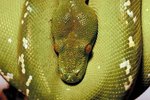
Most people get that some snakes are dangerous and others are not, but not everybody understands how to distinguish between venomous snakes from harmless ones. Many inaccurate traditional guidelines exist, which could cause life-threatening mistakes for laypersons. One such mistaken guideline suggests that all venomous snakes have elliptical eyes; however, round, elliptical and even keyhole-shaped pupils occur in venomous species.
Factors Influencing Pupil Shape
The presence or absence of venom has no correlation with pupil shape, and venomous snakes feature a variety of pupil shapes. For many years, herpetologists thought that elliptical pupils were an adaptation that allowed snakes to see in the dark. However, a 2010 study by F. Brischoux, L. Pizzatto and R. Shine with the University of Sydney, published in the "Journal of Evolutionary Biology," came to different conclusions. After comparing the pupil shapes, activity patterns, hunting styles and phylogeny of numerous snakes, the researchers demonstrated that ambush hunters typically have vertically elliptical pupils, while actively foraging snakes have round pupils. Vertical pupils afford better vision of animals moving in a horizontal plane at varying distances than round pupils do. Vertical pupils were also correlated with nocturnal species, though not as strongly as with ambush hunting modes.
Round Pupils
The family Elapidae -- which includes cobras (Naja ssp.), mambas (Dendroaspis ssp.) and taipans (Oxyuranus ssp.) -- includes some of the deadliest snakes on the planet, all of which have round pupils. Additionally, sea snakes (Hydrophiidae) have incredibly powerful venom and round pupils. In North America, where the myth of the correlation between pupil shape and venom may have originated, coral snakes (Micrurus ssp.) have round pupils.
Elliptical Pupils
Elliptical or catlike pupils are common among many different snake lineages; they're common to all vipers and pit vipers, such as copperheads (Agkistrodon contortrix ssp.) and rattlesnakes (Crotalus ssp.). Consistent with the conclusions of the 2010 study by Brischoux and colleagues, most vipers and pit vipers are ambush hunters who wait for prey to come to them. Additionally, several rear-fanged colubrids, such as brown tree (Boiga irregularis) and mangrove snakes (Boiga dendrophila), possess vertical, catike pupils.
Unusual Pupils
Vine snakes of genus Ahaetulla have unique pupils among snakes -- they are horizontally elongated and have a complex, keyholelike shape. These are thought to play a role in the focusing abilities of these snakes, who possess uncommonly good binocular vision relative to the vision of other snake species. Vine snakes do not possess well-developed fangs like vipers and cobras do; instead, they have enlarged, grooved teeth at the rear of their mouths. Vine snakes primarily use their venom for prey acquisition, and bites do not typically produce serious medical symptoms in humans.
References
- Journal of Evolutionary Biology: Insights Into the Adaptive Significance of Vertical Pupil Shape in Snakes
- Neuro Dojo: Snake Eyes
- Herps of North Carolina: Frequently Asked Questions
- Ecology Asia: Oriental Whip Snake
- Savannah River Ecology Laboratory: Copperhead
- Savannah River Ecology Laboratory: Coral Snake
- Ecology Asia: Gold-Ringed Cat Snake - Boiga Dendrophila
Photo Credits
-
Jupiterimages/Photos.com/Getty Images




